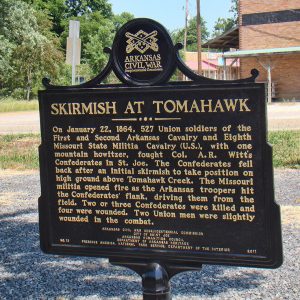calsfoundation@cals.org
Skirmish at Burrowsville
aka: Skirmish at Tomahawk
| Location: | Searcy County |
| Campaign: | None |
| Date: | January 22, 1864 |
| Principal Commanders: | Captain Charles Galloway (US); Unknown (CS) |
| Forces Engaged: | 527 cavalry of the First and Second Arkansas Cavalry and the Eighth Missouri State Militia Cavalry, 1 mountain howitzer (US); Unknown (CS) |
| Estimated Casualties: | Unknown (US); Unknown (CS) |
| Result: | Union victory |
The Skirmish at Burrowsville during the Civil War was part of a larger attempt to drive Confederate and guerrilla forces from northern Arkansas. The overall effort was deemed to be a success by Federal commanders, but their success was somewhat embellished in their official reports.
In early January 1864, Brigadier General John B. Sanborn, commander of the District of Southwest Missouri, received reports of a major Confederate force massing in Newton, Searcy, Izard, and Carroll counties. Sanborn ordered units of the First and Second Arkansas Cavalries (US), along with part of the Eighth Missouri State Militia Cavalry, to move into the area and flush the enemy out in an effort to push the Confederates south to the Arkansas River.
As part of this campaign, Captain Charles Galloway of the First Arkansas Cavalry led 150 men out of Fayetteville (Washington County) on January 10. Reinforced by another part of the regiment on January 19 and other units on January 22, Galloway eventually commanded more than 500 men and a mountain howitzer. After moving through Berryville (Carroll County) and Carrollton (Carroll County), the Federal force continued in the direction of Burrowville (sometimes spelled Burrowsville), which is present-day Marshall (Searcy County).
Approaching Clear Creek on January 22, the Federals began to encounter enemy resistance, and skirmishing between the two sides commenced. Confederate forces organized in front of the Union troops and blocked the road where it entered a narrow pass. Galloway quickly organized his men and pushed through the Confederates, forcing them to flee in confusion. The Federal troops continued to chase the enemy over mountainous terrain until reaching an area called Tomahawk. In a natural defensive position, the Confederate forces tried to hold the area but were ultimately forced to continue their retreat. Pushed back by a dismounted Federal force moving around their rear, the Confederates remounted and moved through Burrowville. Both Federal and Confederate casualties were not made clear in the after-action reports.
The Federals remained in Burrowville overnight before continuing their scouting mission. Continuing to engage Confederate forces whenever they encountered them, the Union men ultimately killed an estimated 100 of the enemy throughout the duration of the scout. Galloway and his men arrived in Yellville (Marion County) on February 15.
While a minor skirmish, this engagement was typical of the fighting that occurred between Union and Confederate forces in this period in northern Arkansas. Small units operating in the mountainous terrain were more effective than large-scale operations, but the losses on both sides remained high.
For additional information:
The War of the Rebellion: A Compilation of the Official Records of the Union and Confederate Armies. Series 1, Vol. 34. Washington DC: Government Printing Office, 1889.
David Sesser
Henderson State University









Comments
No comments on this entry yet.